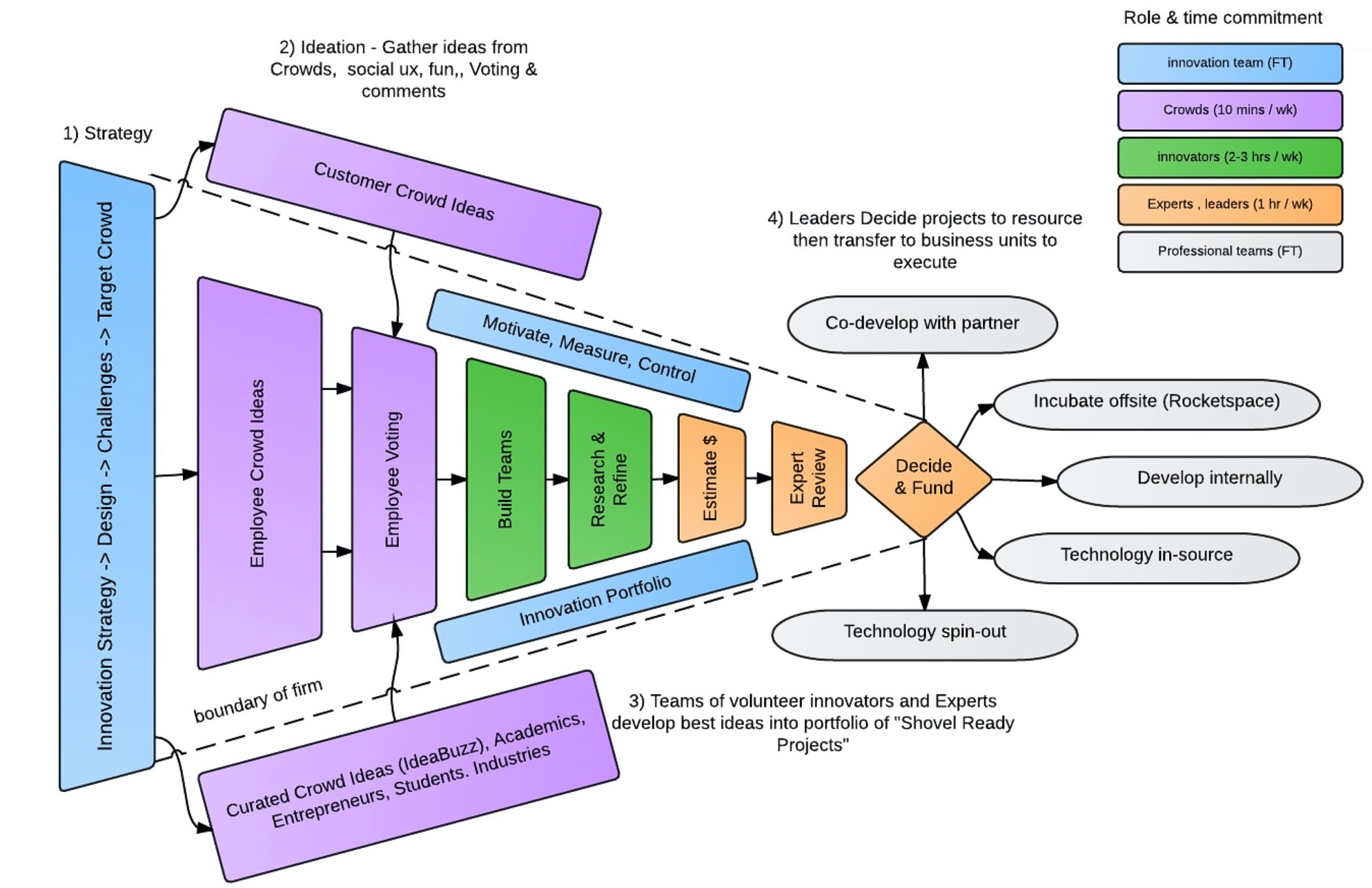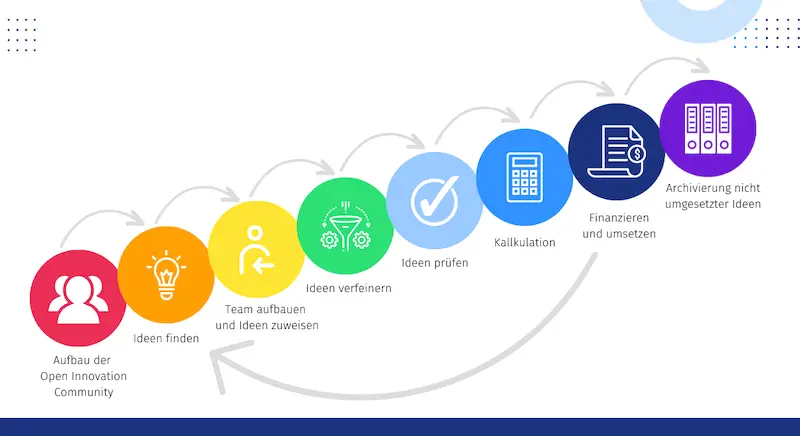Innovation Management
Open innovation is the active strategic opening of the innovation process to the outside world. Open innovation enables companies of all sizes to access an almost endless source of new ideas that can ensure long-term market success.
Open Innovation
- 1 What is Open Innovation?
- 2 Types of Open Innovation
- 3 Benefits of Open Innovation
- 4 Open innovation also gives start-ups and small companies the opportunity to develop innovations
- 5 How to use open innovation
- 6 Change management and mindshift are essential when introducing open innovation
- 7 Tips for promoting flexibility and trust in open innovation
- 8 Open Innovation: The Biggest Challenges
- 9 Use the advantages of open innovation
- 10 Open Innovation Community Platform
- 11 Open Innovation Community Technologies
- 12 Open Innovation with QuestionPro
- 13 1:1 Live online presentation: QuestionPro's innovation management community: We'll show you what's possible!
- 14 Try software for idea management now for 10 days free of charge!
What is Open Innovation?
Open innovation is a groundbreaking paradigm shift. This assumes that companies and organizations can and should use both internal ideas and external ideas - best from anywhere - to develop innovations and thus be able to establish themselves in the market. In a nutshell, this means that internal R&D departments are not the only way forward when it comes to innovation. While such a department can be helpful, it is not the deciding factor in whether or not your organization can generate new ideas. Useful knowledge is now widely available thanks to information technology, which includes the Internet, smartphones and a general culture of regular information sharing. As a result, innovative ideas do not always come from a central location within a single company.
Rather, collaboration in the innovation process is organized in broad horizontal and vertical networks of partners, customers, universities, start-ups, suppliers and competitors and collective intelligence and knowledge is integrated to develop ideas. Approaches such as B. Design Think, which is intended to lead to solving problems and developing new ideas, e.g. B. Involve customers early and iteratively.
Open innovation is becoming increasingly popular
Open innovation is the key to progress. It creates value and improves existing systems so that new ideas can arise. Innovation research shows that 61 percent of managers support open innovation to generate ideas. Positive changes are brought about through collaboration and exchange, which leads to better ways to implement products and services.
Generate ideas cost-effectively with open innovation
With open innovation and appropriate idea management systems and software, you can collect ideas both internally and externally without having to invest a lot of money. Regardless of whether you want to collect ideas from your employees or from so-called open innovation platforms: with the right systems you can initiate innovations easily and cost-effectively.
Implementation ultimately makes the difference
Of course, these changes in the innovation process of your innovation programs do not mean that there is no longer a competitive advantage. There is simply a new differentiator. The new competitive advantage is the act of implementation, but no longer the act of generating ideas. Too many companies generate amazing new ideas and never do anything with them. Innovation will always be based on real change, not outstanding ideas alone. Companies still need to take the new ideas and processes that are generated and do the hard work of turning promising concepts into products and services that serve customers. The real differentiator between companies today is that new ideas are effectively translated into new processes and products. Implementation work is now the main differentiating factor between success and failure.
Erosion of closed innovations
The erosion of “closed innovation” has occurred for various reasons. There is so much knowledge existing and shared outside of formal research organizations that the general public (or subsets thereof, such as college students in a particular field) can be a source of transformative ideas. Furthermore, people change jobs and take their knowledge with them, perhaps to a supplier or other potential open innovation partner. Mostly, however, open innovation has gained traction because of its potential to deliver on the promise of transformative and disruptive ideas.
Types of Open Innovation
A classification of open innovation types takes place according to the direction:
- Inside-Out Open Innovation: The direction is from inside to outside, i.e. H. the internal know-how is exploited to external partners, e.g. own patents are awarded to partners in exchange for licenses.
- Outside-In Open Innovation: The direction is from outside to inside, meaning ideas and inventions are integrated from outside into the company and the innovation process.
The aim of Outside-In Open Innovation is to obtain market information, ideas, solutions, technologies or feedback from external parties- to obtain ideas and impulses for new products and services through, for example, crowdsourcing, idea competitions or lead user workshops,
- Development of new technologies and innovations in cooperation, such as in research or co-creation with customers
- in order to obtain feedback on new innovations from customers as early as possible through concept and prototype testing.
Benefits of Open Innovation
If innovation management is carried out extensively in the classic sense, companies only rely on internal experts - and thus on a small, limited group of people with a smaller solution horizon. The advantages of open innovation are access
- a larger pool of innovative ideas with different perspectives and expertise,
- A broader knowledge, for example about or directly from customers and their needs and
- greater access to new technologies and expertise as well as their application potential.
In addition to access, other benefits include:
- faster development times due to existing expertise,
- lower development risks due to the direct involvement of partners and customer groups,
- Potential for funding through collaboration with universities and research institutions.
Open innovation also gives start-ups and small companies the opportunity to develop innovations
For decades, companies focused on developing innovative ideas internally. They asked specifically Employees for research and development projects, and an arms race mentality developed in which large companies tried to outdo each other in developing new ideas. Smaller companies were left out because they didn't have the budget. With no budget and no access to the thinkers who created new ideas, they were left behind. Today the story has changed significantly. The Internet and the information economy have leveled the playing field, and even small startups can come up with ideas Assistance bring a different process to market that includes innovation crowdsourcing, crowdfunding and implementation only when the market has proven itself.
Because organizations of all sizes can collect, test and implement ideas that prove useful, open innovation has become a kind of “equalizer.” Large research and development budgets are no longer a competitive advantage when it comes to idea generation. Because of open innovation, the boundaries between an organization and its environment have become less clear. The market influences the company, and the company influences the market at every step of the way Research, development and introduction.
How to use open innovation
To leverage open innovation in your company or organization, you must first change the mindset of leadership and stakeholders to understand the open innovation mentality and discard old ways of thinking. Once everyone is on board, consider implementing systems, such as innovation Community from QuestionPro,, which help you prepare for the complexity of idea management and relieve you of a lot of administrative work.
Open innovation technology
Open innovation is not an option, but actually an essential and additional possibility. By adopting open innovation, you can generate new ideas at significantly lower costs than ever before. With the right system, you can collect ideas, evaluate ideas, Feedback process, prepare ideas for implementation and automate approval processes. A complete “out of the box” idea management system like QuestionPro, which can be used turnkey, is an ideal solution. QuestionPro supports you throughout the entire innovation process!
The open innovation process
The open innovation process inevitably includes several phases:
Building the Open Innovation Community:
Building the Open Innovation Community is really easy if you choose a technology that basically already contains everything you need for your innovation management, for example
- an idea board
- Possibility of member recommendation
- Ranking and promotion tools
- commenting features
- team buildingFeatures
- Brainstoarming mode
- Engagement tools
- Innovation analysis tools
Find ideas:
At the beginning of the Open Innovation process, you will collect a wealth of ideas and your Open Innovation members will discuss, evaluate, comment and sort these ideas. The most popular ideas will rise to the top, giving you a shortlist of excellent ideas to commit to implementing.
Build a team and assign ideas:
Once you've collected the most popular open innovation ideas, it's time to test them to see which ones will perform well in the real world. In the Build Team phase, you assemble a team of experts, champions, and implementers around the most promising of the new ideas. Raw ideas without an owner (orphan ideas) are unlikely to survive and develop into true innovation. What is needed is a dedicated team to nurture, develop, research and expand the idea into a fully thought out proposal.
Refine ideas:
As you refine the ideas in the open innovation process, ask the idea teams to provide additional information about their proposals and to flesh out the idea. They answer questions and refine the innovations into suggestions that can be implemented. Only the best and most viable ideas will make it out of this stage.
Check ideas:
The review phase in the open innovation process shows which projects deliver the highest results depending on the weighting of various strategic factors (e.g. which ideas are most innovative, patentable, cost-effective and will bring benefits in the next financial year). Managers choose which ideas to support and fund. As a rule, a management team consisting of people responsible for various departments such as development, Product management, Marketing, Sales etc. in collaboration with the innovation team and other senior managers select the projects that should be funded and taken to the next level.
Calculation:
On the path to implementation, it is time to estimate the cost of implementing each open innovation idea. The cost-benefitAnalysis will help your leaders and stakeholders determine which ideas are most viable and deserve to be implemented.
Financing and implementation:
As mentioned earlier, the true competitive advantage in today's business world is execution. In the fund phase, your organization sets the timeline for funding and implementing the winning idea. It is crucial to plan for funding for the long term, not just for the initial launch. Care should be taken to ensure that every department involved is present at this stage so that there is no resentment or dispute between funding departments.
Archiving ideas that have not been implemented:
The archiving phase is often seen as a neglectable thought, but it is crucial to maximizing the benefits you get from open innovation projects. The archive allows you to save ideas that are not currently being implemented along with any notes from the process so that you can access them in the future. The archive allows you to advance new innovations without having to start an entirely new innovation project each time by searching, unearthing and perhaps further developing archived ideas. Or the archive can serve as a source of inspiration.
Change management and mindshift are essential when introducing open innovation
The idea of change can be very exciting. Many people want things to get better in the abstract. However, when it comes to actually changing the way they do their everyday work, many people change their mindset. Perhaps you have experienced this in your own organization. Maybe you had people who were enthusiastic about brainstorming and new ideas. Maybe you had leaders who embraced the idea of innovation. But when it came time to change things, and when it came time to budget for those changes, suddenly no one was available and everything is “too much for now” and is postponed.
It's frustrating, but it's incredibly common in many organizations. For a company to advance in today's market and have a true competitive advantage, there must be a commitment to implementing the proposed changes. You may feel like you're swimming upstream, but learning about change management and helping everyone stay on the same page can make a big difference in how many innovative ideas are adopted by your organization.
Tips for promoting flexibility and trust in open innovation
Open innovation research by business and innovation experts in Amsterdam found that five key strategic actions promote flexibility and trust in open innovation projects and ensure that more great ideas are developed and implemented:
- Creating a multi-layered network – to attract more people to an open innovation project at more levels and reduce “silo” thinking
- Promote equal ownership – so that everyone involved has a sense of ownership and responsibility for an idea that is selected for development.
- Intentionally encouraging discussion and collaboration (perhaps using messaging systems like Slack) helps everyone monitor progress and get involved.
- Setting intermediate milestones – because “staging” the innovation process increases transparency and helps the project feel less overwhelming.
- Allowing the initial concept to be shaped during development – so that the idea can be improved while maintaining the core principles of the idea
- Early prototyping – because presenting something tangible can help convince stakeholders of the value of an idea and help them articulate concerns and feedback while the idea is still at a more “fluid” stage
Open Innovation: The Biggest Challenges
Innovation works best when it incorporates a wide range of perspectives. Open innovation, in which a company invites external groups such as academic organizations and nonprofits to submit ideas to address challenges, can be an excellent way to gain these perspectives. However, some challenges need to be taken into account when developing your innovation strategy.
Efficient filtering
In order to find something, you have to know what you are looking for. Before you launch a challenge or send out an invitation, sit down with your team and create some realistic, clear guidelines to filter the ideas you receive internally and allow those developing a proposal to do so Challenge to better understand. Some variables to consider could be your overall budget, the size and weight of a product, the “must-have” functions or features, or a time frame in which to implement the idea.
These should be carefully kept to a minimum, at least externally. It is not uncommon to find challenges built around a single variable, such as finding new and effective uses for plastic waste. Success often lies in the exact definition of the topic!
Efficient structure
Open innovation can lead to an enormous number of new ideas. Before you launch an open innovation program, you should set up an infrastructure around who on your team will filter the ideas that meet your needs. This ensures that no one is overwhelmed and provides good points of contact for the curious. Also ensure that those doing the sorting know they can ask for help and that key stakeholders are represented in the process. Especially when a challenge prevails, this will save time on all sides of the equation.
Efficient research
One of the downsides of open innovation is that sometimes a brilliant idea is so good that someone not only already had it, but also patented it. Sometimes this is a blessing: what may seem like an expensive proposition is instead a product designed for a different purpose that you can easily use to address your challenge. WD-40, for example, was originally developed to protect rocket casings from rust. However, it was found to have versatile uses in the home as a lubricant and protectant, and it was made into a consumer product.
In other cases, however, you may not be able to find a product; after all, not all patents are on the shelves. Therefore, you should have a process in place to review ideas to determine what is legally enforceable and what is already available. In some situations, it may even be within your policy to purchase the product or license the patent. If you examine how the process addresses your particular challenge, it might inspire an approach that is better suited to your particular industry.
Use the advantages of open innovation
Open innovation is a method in which companies or organizations reach out to other companies, individuals and the general public to create innovative products and services. Thanks to the Internet and modern community technologies, open innovation is now very easy. Knowledge is widespread, and relying solely on internal research can significantly limit an organization's ability to innovate. Open innovation has helped advance many industries and areas, such as IT, healthcare and even politics.
An example of open innovation that everyone is familiar with is open innovation communities for mobile devices. Both Android and Apple have created open innovation communities that encourage app development and have resulted in a huge number of apps.
Combining internal company resources with external resources to innovate brings many important benefits, including better products and services, lower research costs, better risk diversification, and faster time to market. And of course the generation of many outstanding ideas.
Open innovation is not a new idea, but it has become more popular with the emergence of technologies that facilitate the exchange of innovations and ideas. It is becoming a mainstream form of innovation, leading to new types of partnerships.
Better product and service offerings
Open innovation can lead to improvements to existing products and services or to the development of completely new products and services. Especially for newly founded companies, start-ups, the market launch of the first product can be significantly accelerated. Open innovation makes bringing new products and services to market both more cost-effective and less risky. Think about how the world of apps has influenced phone and tablet manufacturers to improve their hardware specifications over the years to meet consumer demands.
Lower research and development costs
Today's companies must invest proportionately more in research and development than companies of previous generations just to achieve the same level of results. A wise use of R&D resources is essential, and open innovation supports R&D while keeping costs under control. Relying on the ideas of external partners such as start-ups, individuals or colleges and universities costs less, while at the same time opening organizations up to new ideas that may never have been conceived under more restrictive internal innovation models.
Better risk diversification
Open innovation helps mitigate risk by being shared across multiple organizations. First, multiple stakeholders are investing their resources in open innovation initiatives. On the other hand, the different viewpoints that open innovation brings with it can help reduce the risks of the innovation getting out of hand.
Faster time to market
Open innovation accelerates time to market because many tasks can be completed in parallel by multiple organizations. This helps improvements to old products and innovative new products come to market faster so ROI can be recognized more quickly.
Open Innovation Community Platform
Open Innovation leverages the experience and knowledge of an entire network to develop ideas. Also known as a crowdsourcing community, an open innovation platform, also known as an open innovation community, simplifies the generation of ideas and the tracking, evaluation and commenting of ideas in order to develop valuable solutions in collaboration with a large number of people. Charities and government organizations, colleges and universities, and small and large businesses can all benefit from an open innovation approach to, for example, promote growth, improve image, develop new products, or improve existing products.
Open Innovation Community Technologies
An open innovation platform can help collect and drive exciting and actionable ideas for cost reduction, product development, customer experience, efficiency and much more. The community can develop ideas together towards feasibility with the help of comments and numerous rating options. A transparent process helps to keep everyone involved up to date. It is the large number of participants and the management of ideas using innovative community technology that accelerates and simplifies idea generation and idea development. The QuestionPro Open Innovation platform is the key to developing and implementing a successful open innovation strategy. Participants can register on the platform with just a few clicks, take part directly in the innovative idea generation process and help the company.
Open Innovation with QuestionPro
QuestionPro offers a community platform for open innovation. It is designed to fit any organization in terms of functionality, with the ability to configure the tool to support your processes, technologies, culture, innovation maturity and strategy.
Open Innovation is a fairly young and new methodology and we are aware that many of our customers are in the experimental phase of maturity in adopting Open Innovation as a process. We structure our offering to adapt to your level of readiness and support our customers with a simple interface, comprehensive training, a dedicated innovation architect, a 24/7Support, an online customer forum and annual conference where our customers come together to share their stories on the front lines.
QuestionPro is serious about improving the way companies innovate, and we have the world's largest innovation database with more than 500k ideas. We collaborate with several universities in open innovation-based research to analyse this data to improve our customers' success through both better products and better thought leadership.

Schematic representation of the Open Innovation approach.
1:1 live online presentation:
QuestionPro’s innovation management community: We’ll show you what’s possible!
Arrange an individual appointment for an online presentation from the QuestionPro innovation community, with which you can implement open innovation approaches quickly and easily.
Try software for idea management now for 10 days free of charge!
Do you have questions about open innovation or innovation management? Simply contact us via contact form. We look forward to a dialogue with you! You too can test QuestionPro for 10 days free of charge and without risk in depth!
Test the agile market research and experience management platform for qualitative and quantitative data collection and data analysis from QuestionPro for 10 days free of charge
FURTHER KEYWORDS
SHARE THIS ARTICLE
KEYWORDS OF THIS BLOG POST
Open Innovation | Innovation Management | Idea management | Community





